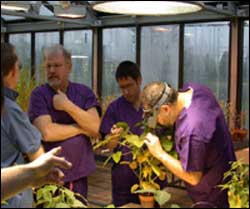Experts available to speak on the possible discovery of Asian Soybean Rust spores

Virginia Tech scientists say that there has been a change in the status of the fungus causing Asian Soybean Rust but that the new information is still too preliminary for any action on the part of the Commonwealth’s soybean producers.
A single cluster of six urediniospores found at Virginia Tech’s Tidewater Agricultural Research and Extension Center in Suffolk was identified by morphological characteristics as matching the description of the fungus.
“The spores in question appear to resemble the causal agent of Asian Soybean Rust, Phakopsora pachyrhizi, said Erik Stromberg, interim head of the Department of Plant Pathology, Physiology and Weed Science in Virginia Tech’s College of Agriculture and Life Sciences. “But we can not be absolutely certain that they are. The weather conditions between Aug. 5 and 11, the time the sample was found, were extremely hot and dry and not conducive for promoting the infection process. Researchers found no indication of Asian Soybean Rust when they examined the adjacent sentinel plots and other nearby fields. At this time, no recommendation for fungicide is warranted in Virginia. It is highly unlikely that Asian Soybean Rust will be detected in any soybeans in Virginia for at least three weeks.”
The presence of spores does not mean the infection is present. It means that the scouting for the disease will be intensified until the crop progresses through the most vulnerable stages from beginning pod fill up to full seed.
Farmers suspecting the presence of soybean rust in a field should contact the local Virginia Cooperative Extension office for help in confirming its identity. Virginia Tech has an intensive ongoing program for detection of the disease and warning growers of the need to apply fungicide sprays for disease control. Reports on the status of disease and field scouting are posted twice weekly on the website and there are recorded updates at 1-804-657-6450 ext. 103.
Soybean’s farm gate value in Virginia has ranged from $75 million to $100 million annually. The early warning provided by the scouting system will permit growers to act only when necessary. The primary tool for growers is the use of fungicides, which are costly and will not be effective if applied too early or too late. Research continues on finding resistant varieties.
Media Contact
All latest news from the category: Agricultural and Forestry Science
Newest articles

Sea slugs inspire highly stretchable biomedical sensor
USC Viterbi School of Engineering researcher Hangbo Zhao presents findings on highly stretchable and customizable microneedles for application in fields including neuroscience, tissue engineering, and wearable bioelectronics. The revolution in…

Twisting and binding matter waves with photons in a cavity
Precisely measuring the energy states of individual atoms has been a historical challenge for physicists due to atomic recoil. When an atom interacts with a photon, the atom “recoils” in…

Nanotubes, nanoparticles, and antibodies detect tiny amounts of fentanyl
New sensor is six orders of magnitude more sensitive than the next best thing. A research team at Pitt led by Alexander Star, a chemistry professor in the Kenneth P. Dietrich…





















